by Lorna McDowell // Sept. 20, 2024
This article is part of our feature topic Accessibility.
The topic of rest, or rather the lack of it, has become ubiquitous. If you asked friends, colleagues or even strangers on the street about their daily lives, a common theme would likely emerge: most people are tired and not getting the rest they need. Neoliberal values prioritize constant work and efficiency over leisure and the ability to rest becomes an unequally distributed luxury—a privilege often dictated by socioeconomic class. For those marginalized by race, gender, disability, chronic illness or economic status, rest is even more elusive.
In this cultural climate, the notion of rest as a form of resistance has been at the forefront of art and social media discourses for a while, signposting a shift away from the toxic “girl boss” mentality that glamorised overwork. Thinkers like American poet and activist Tricia Hersey, alongside scholars such as Dr. Saundra Dalton-Smith, Sonya Renee Taylor and Dr. Devon Price have been advocating for rest as a crucial tool in combating racial and social injustices. Inspired by these authors, the exhibition ‘Libraries of Rest’ at transmediale studio in Wedding’s silent green art space, asserts that rest is highly politicised. As the artist, Ciara Barker, describes, most of us are “too busy and exhausted to imagine a better future.”
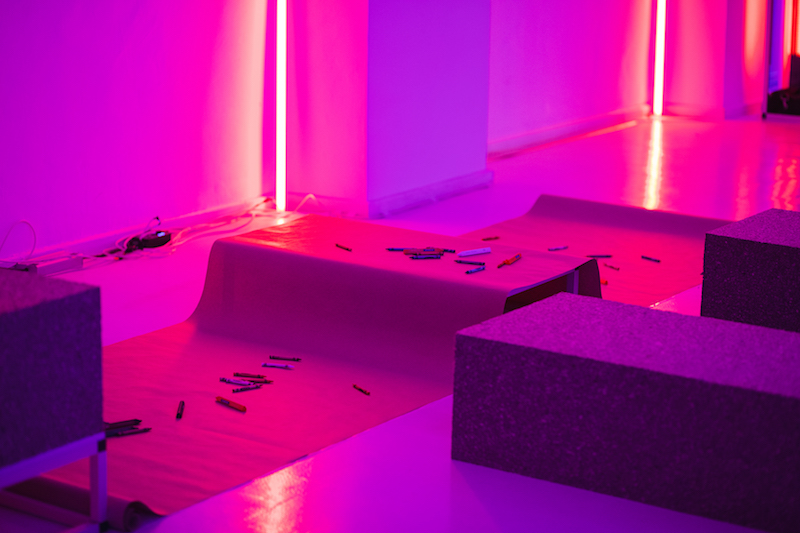
Ciara Barker: ‘Libraries of Rest,’ 2024, installation view at transmediale studio // Photo by Katie O’Neill
Imagining a world where rest is a basic human right can feel daunting. Concepts like mutual aid and collective care are buzzwords that we hear a lot, but what do they look like in practice? In the show, the Irish artist speaks to the heart of this issue with an interactive installation that explores the potential role of rest in shaping a more just society. Barker uses spatial design to reflect on the fact that while rest has become an urgent topic, it is still far from being a basic right for all. There remains a constant demand for productivity, instilling guilt in those who seek rest—a cycle we must work to collectively unlearn.
Considering the exhibition’s title, one might ask oneself: how can the traditional, educational concept of the library, one of our most recognisable global institutions, be repurposed to facilitate this kind of unlearning? And how can an art exhibition do more than pay lip service to the urgent topic of rest, modeling examples that plant seeds in our shared consciousness, with the hope of one day shaping a more accessible, playful and restful life for all?
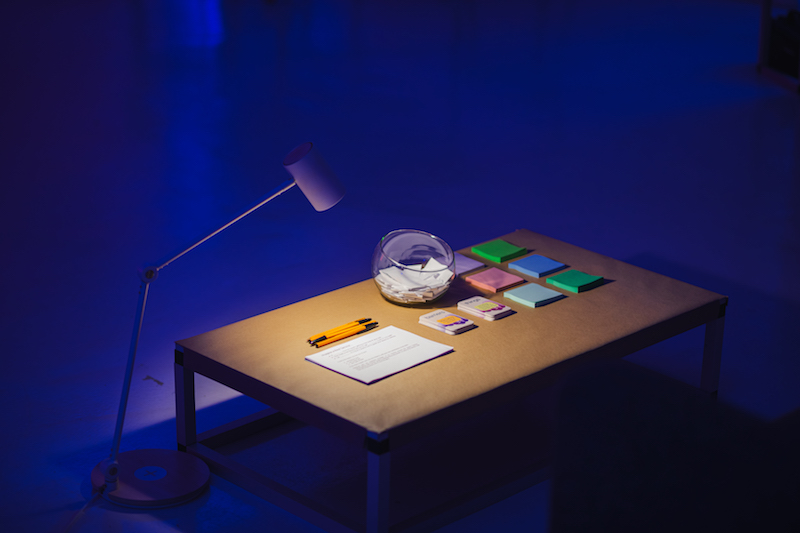
Ciara Barker: ‘Libraries of Rest,’ 2024, installation view at transmediale studio // Photo by Katie O’Neill
Accessibility is central to the exhibition’s design. The show can be approached both from the front entrance, accessible via stairs, and a back entrance that is accessible via an elevator. The opening curatorial statement and first activity station are mirrored on both sides, ensuring that the entrance with step-free access offers the full, uncompromised experience. There are bathrooms nearby and designated COVID-safe masking hours. Additional amenities like water, WiFi and wireless phone chargers add to the sense that this is not just an exhibition, but a place where people are invited to linger and recharge, not unlike how some community members might linger in a library.
The installation weaves through the space, punctuated by a number of optional activity stations and an abundance of seating—bean bags to sink into, soft sponge blocks that on first glance appear to be concrete, office tables and chairs and a therapist’s couch. A 40-minute immersive soundscape by producer Mankyy plays on a loop in the background. Created for the installation, the track oscillates through samples that vary from soporific, ambient ASMR, melodic, to a conversation that reflects on societal attitudes to rest as something reserved for the afterlife. For those sensitive to noise intrusion, earplugs are provided—another thoughtful gesture in a space designed to accommodate diverse needs.
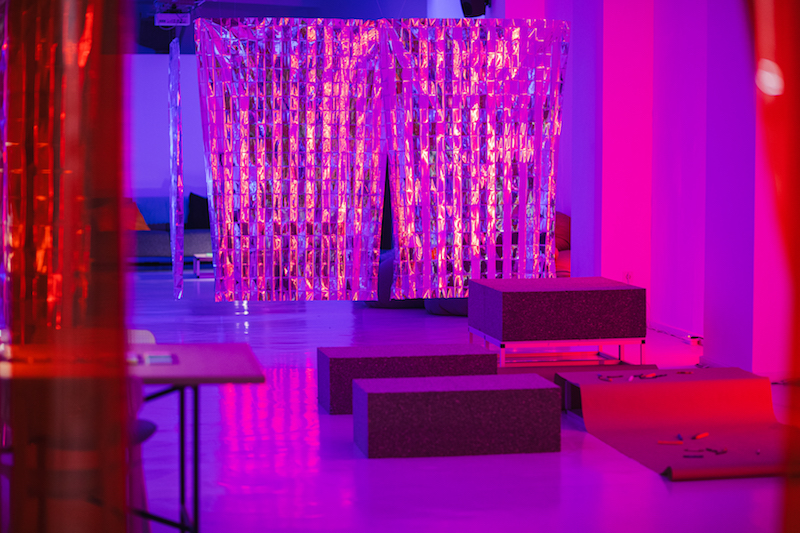
Ciara Barker: ‘Libraries of Rest,’ 2024, installation view at transmediale studio // Photo by Katie O’Neill
The soft lighting that fills the space is predominantly red and blue, merging into pink as it reflects off the sheets of Mylar that hang throughout and divide the space. Mylar is the polyester film used to insulate marathon runners and in emergency situations. Both the lighting and Mylar sheets are key elements of Barker’s visual language, having appeared in her past installations. The semi-transparent material is responsive to body heat and movement, and as I move through the space, the sheets are repelled from my body as I get closer to them, creating the sense that we are in a delicate choreography with each other. Barker’s work typically invites this kind of physical interaction, offering viewers a tactile, personal experience that radically confronts the effects of socially constructed divides.
The first interactive element of the exhibition is a card game that prompts visitors to imagine what a “rest service” might look like. We are invited to pull a card that poses questions, choose answers on small slips of paper from a jar and write or draw our responses on post-it notes that can be added to a growing wall of contributions. This wall, ever-changing and unfixed, represents a collective ideation. These activities give us the opportunity to expand our collective understanding of rest beyond the narrow confines of sleep or relaxation. Just as a traditional library space exists to serve the community, the notion of a “rest service” also seems intended to facilitate a community-oriented goal.
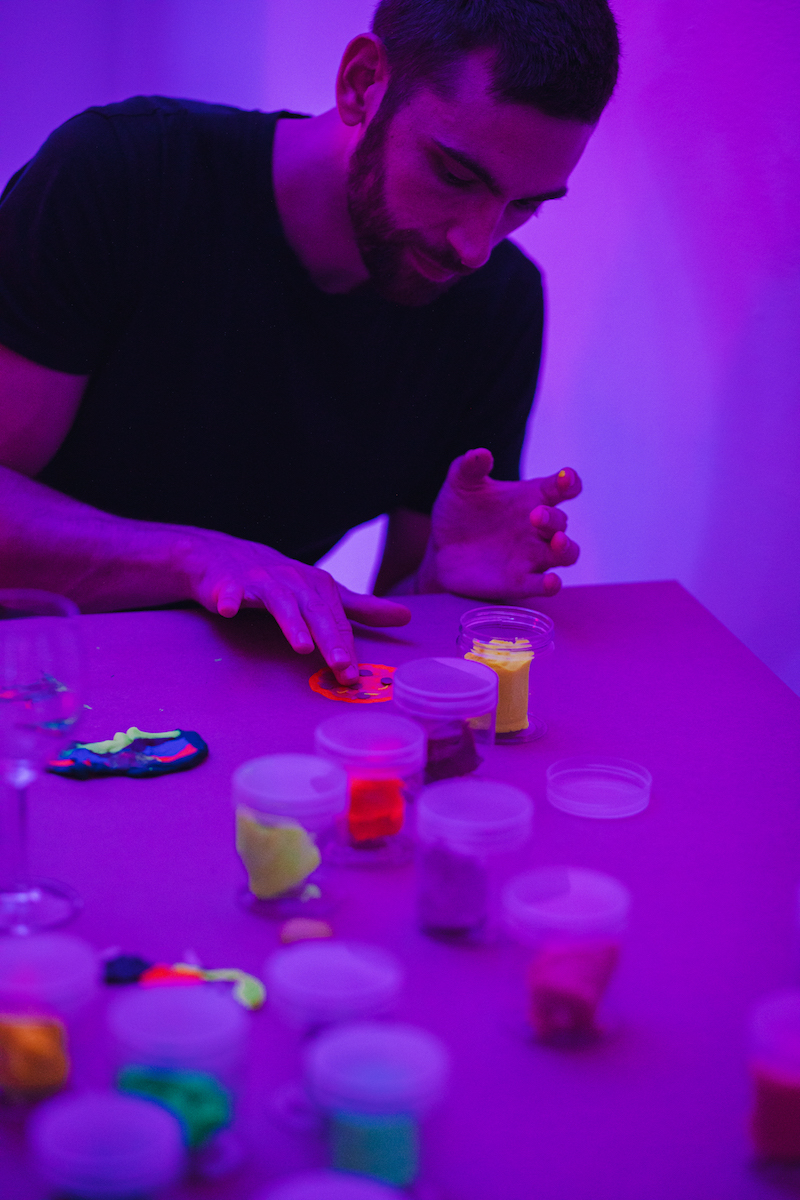
Ciara Barker: ‘Libraries of Rest,’ 2024, installation view at transmediale studio // Photo by Katie O’Neill
Moving further into the exhibition, the environment shifts from angular and practical—the office tables—to the softer, more relaxed spaces of foam seating, bean bags and the couch. A roll of paper spread along the floor is filled with drawings and scrawled messages. At another table, visitors can mould their own small sculptures from coloured plasticine and then add them to a presentation table nearby. This activity is an opportunity to enjoy the restful effects of creating something with your hands, and makes space for playful, individual research studies into the vast possibilities of what rest could mean.
Bean bags are one of the most inviting features of the exhibition, providing a space for visitors to rest, sleep or simply sit in quiet contemplation. There’s a lone bean bag concealed behind a sheet of hanging Mylar, where visitors can sit back and watch the reflected light dapple across the ceiling, and a large pile of bean bags along the back wall of the space that invite you to sprawl out or sit with company. These areas, both open and slightly more private, cater to each person’s comfort with being observed. This attention to detail reflects the installation’s broader theme of inclusivity and the desire to create a space where everyone feels welcome, whether they seek interaction or solitude.
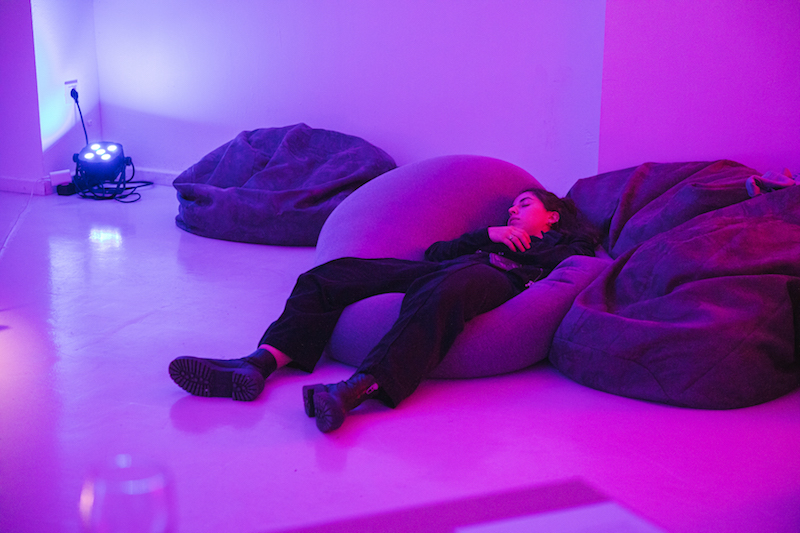
Ciara Barker: ‘Libraries of Rest,’ 2024, installation view at transmediale studio // Photo by Katie O’Neill
‘Libraries of Rest’ offers a radically different approach to the detached experience of viewing art against a starkly lit gallery wall. The visual language is not like that of a traditional library—there are no shelves filled with books or desks lined with computers. But it’s interesting to note how the spatial arrangement warmly invites a similar solitary or collective experience of research and reflection. The Mylar sheets divide the space in the same way that bookshelves might, but instead of holding reading material, they reflect the ephemeral thoughts and conversations on rest that are ignited by the exhibition. Their glow and responsive qualities are also key to an immersive spatial experience that encourages visitors to manifest these thoughts and reflections in the form of words, drawings or plasticine creations.
The artist’s intention is to archive these outcomes in order to create “a library of ideas for accessing rest,” which one could imagine as a wider project and a future resource. In this way, the exhibition not only challenges our perception of what a library can be, it also serves as a model for how we might prioritize rest in our lives going forward. After all, it is only through enough rest, reflection and community support that we might unlearn our deeply conditioned attitudes to productivity and adopt new ways of being.
Artist Info
transmediale studio
Ciara Barker: ‘Libraries of Rest’
Exhibition: Sept. 11–22, 2024
zeitgeistirland24.com/…/libraries-of-rest
Gerichtstraße 35, 13347 Berlin, click here for map



















